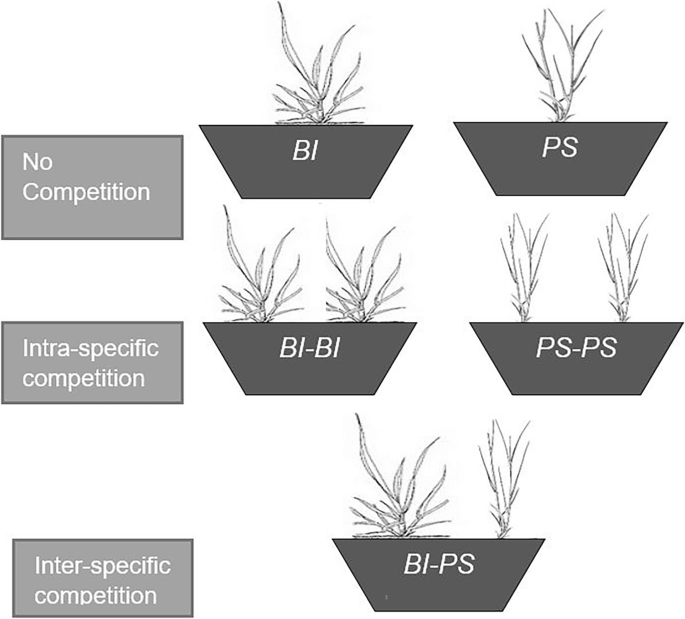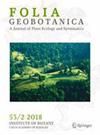Belowground growth strategies of native and invasive rhizomatous perennial grasses in response to precipitation variability, clipping, and competition
IF 1.2
4区 生物学
Q3 PLANT SCIENCES
引用次数: 0
Abstract
Abstract Invasive clonal species may exhibit different growth strategies than their native clonal competitors. In this study, we examined the spatial distribution of tiller outgrowth and the bud bank by comparing the investment in phalanx versus guerilla growth of a native and invasive perennial grass in North America. We also examined the effect of altered precipitation frequency, clipping, and competition on their clonal growth strategies. Investment in phalanx and guerilla growth was assessed by examining live propagule and tiller production from the plant crown versus its rhizomes. Although invasive Bromus inermis and native Pascopyrum smithii exhibited similar clonal growth strategies as young seedlings, their clonal growth strategies significantly differed by the end of their first growing season. Pascopyrum smithii invested in dual phalanx and guerilla tiller outgrowth and bud placement, and B. inermis primarily invested in phalanx tiller outgrowth and bud placement. Competition rather than intra-annual precipitation variability and clipping altered the clonal growth strategy of these species. Intra- and inter- specific competition did not alter tiller outgrowth for either species. However, inter-specific competition caused both species to alter their bud placement. Bromus inermis shifted more buds from phalanx to guerilla positions while P. smithii shifted in the opposite direction. This may enable invasive B. inermis to expand while confining native P. smithii to more localized areas in the future. Clonal growth strategies appear to be species specific and responsive to inter-specific competition. Investigating the belowground bud aspect of clonal growth can reveal the mechanism driving the future aboveground clonal growth strategy of native and invasive rhizomatous grasses and help inform the patterns of invasion within a plant community.

原生和入侵根状多年生禾本科地下生长策略对降水变异、剪枝和竞争的响应
入侵克隆物种可能表现出与本土克隆竞争对手不同的生长策略。本研究通过对北美一种原生禾草和入侵禾草的方阵生长和游击生长的投资进行比较,研究了分蘖生长和芽库的空间分布。我们还研究了降水频率、修剪和竞争对其克隆生长策略的影响。通过检查植物冠与根茎的活繁殖体和分蘖产量来评估对方阵和游击生长的投资。尽管入侵雀稗和本地雀稗在幼苗时表现出相似的克隆生长策略,但在第一个生长季结束时,它们的克隆生长策略存在显著差异。石菖蒲对双指骨和游击式分蘖的生长和芽的着落有显著的促进作用,黄菖蒲对指骨分蘖的生长和芽的着落有显著的促进作用。竞争改变了这些物种的克隆生长策略,而不是年内降水变化和剪枝。种内和种间竞争对两种的分蘖生长均无影响。然而,种间竞争导致两个物种改变了它们的芽位置。凤梨将更多的芽从方阵转移到游击式位置,而凤梨则相反。这可能会使入侵的白僵菌扩大,而在未来将本地的史密斯僵菌限制在更局部的地区。克隆生长策略似乎是种特异性的,对种间竞争有响应。研究根状禾本科克隆生长的地下芽向,可以揭示驱动本地和入侵根状禾本科地上克隆生长策略的机制,并有助于了解植物群落内的入侵模式。
本文章由计算机程序翻译,如有差异,请以英文原文为准。
求助全文
约1分钟内获得全文
求助全文
来源期刊

Folia Geobotanica
生物-植物科学
CiteScore
2.40
自引率
0.00%
发文量
18
审稿时长
>12 weeks
期刊介绍:
The journal Folia Geobotanica publishes articles in vegetation science, plant ecology and plant systematics, including the topics of temporal community patterns, population and ecosystem ecology, and invasion and conservation ecology. Within the field of plant systematics, Folia Geobotanica welcomes papers on systematic and evolutionary botany, including phylogenetic reconstructions, phylogeographic and biogeographic inferences, studies of microevolutionary processes, taxonomic studies, and broader taxonomic revisions.
 求助内容:
求助内容: 应助结果提醒方式:
应助结果提醒方式:


